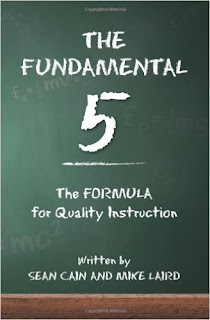Last time I posted, I spent most of the time talking about one of the fantastic books I read this summer. Specifically, I described how to implement two very important pieces of the Fundamental 5. To read the previous blog post, click here.
Today I will focus my energies on explaining the third component of the Fundamental 5: Frequent, Small-Group, Purposeful Talk about the Learning, or FSGPT. So, I'll be honest, I am a task master in my classroom. I like to fill my students' brains up with as much knowledge as I possibly can while they are with me. Since I do check for understanding in a variety of ways and because I like to spend more time explaining the content, it often leaves little time for anything else. Well, the Fundamental 5 has helped me change my ways. Teachers should take advantage of this strategy after they have taught an important concept or after 10-15 minutes of direct instruction.
The strategy goes something like this: A teacher provides a "seed question" related to the instruction. So for example, a seed question could be, "Compare the criteria used to distinguish a physical change from a chemical change." Students discuss the answer to this question in groups of 2-4. It's never a long conversation - 30 seconds to 3 minutes, tops. This aspect of the Fundamental 5 allows students to focus on the learning as well as bring higher levels of understanding on Bloom's. Of course, during the discussions the teacher must remain in the "Power Zone" to monitor insights or misunderstandings.
 For years, one thing I always talked about with new teachers is how students have a type of "kid speak" that maybe adults are not so in tune with. Allotting class time for your students to discuss concepts allows for increased learning because a student's peers can serve as a "translator" for a student who maybe does not understand "adult speak" as well.
For years, one thing I always talked about with new teachers is how students have a type of "kid speak" that maybe adults are not so in tune with. Allotting class time for your students to discuss concepts allows for increased learning because a student's peers can serve as a "translator" for a student who maybe does not understand "adult speak" as well.
So this is one practice that I plan to implement a lot more this coming school year. Recently, my district has purchased a wonderful web application called Nearpod that can help. My school is 1:1 - every high school student has a Chromebook. It is my plan to implement this component of the Fundamental 5 by taking control of the students' screens and having them answer questions as a group in real time. Nearpod allows students to diagram, answer multiple choice questions, and provide short answers to questions. It even allows me to display student work anonymously on the overhead. Truly, this is an incredibly engaging tool, and combined with my new knowledge of the Fundamental 5, I know my students will benefit immensely.
Next time I'll be finishing up this book review with the last two components of the Fundamental 5: Recognize and Reinforce and Writing Critically. Until then... happy teaching! :)
 Ms. Razz is an enthusiastic chemistry teacher in New Jersey. She often counts herself to sleep at night using molecules or by reciting Avogadro's number. (For real.) She believes that every student has the power to learn anything, even chemistry. After all, she remembers this hustle didn't always come easy to her. She's also a Teachers Pay Teachers seller and you can view and purchase her lessons here.
Ms. Razz is an enthusiastic chemistry teacher in New Jersey. She often counts herself to sleep at night using molecules or by reciting Avogadro's number. (For real.) She believes that every student has the power to learn anything, even chemistry. After all, she remembers this hustle didn't always come easy to her. She's also a Teachers Pay Teachers seller and you can view and purchase her lessons here.
Next time I'll be finishing up this book review with the last two components of the Fundamental 5: Recognize and Reinforce and Writing Critically. Until then... happy teaching! :)
 Ms. Razz is an enthusiastic chemistry teacher in New Jersey. She often counts herself to sleep at night using molecules or by reciting Avogadro's number. (For real.) She believes that every student has the power to learn anything, even chemistry. After all, she remembers this hustle didn't always come easy to her. She's also a Teachers Pay Teachers seller and you can view and purchase her lessons here.
Ms. Razz is an enthusiastic chemistry teacher in New Jersey. She often counts herself to sleep at night using molecules or by reciting Avogadro's number. (For real.) She believes that every student has the power to learn anything, even chemistry. After all, she remembers this hustle didn't always come easy to her. She's also a Teachers Pay Teachers seller and you can view and purchase her lessons here.










